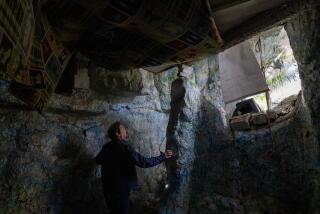Frederick Shaw was crazy -- like a fox
- Share via
Mystery obscures the life of Frederick Shaw (1827-1914), the indigent inventor, health promoter, social crusader and purported naked man of Laurel Canyon.
Did he really attempt to hang-glide from atop a second-story building in downtown Los Angeles, breaking his hip in the process?
Did his mail-order bride really flee his property when she discovered that he lived in a tree?
And was he really insane, as a judicial panel ruled, or just a hermit whose vegetarian diet, clothing-optional lifestyle and boundary disputes annoyed the neighbors?
Nineteenth century news accounts were not always reliable, so the answers are difficult to find, though it appears that Shaw was not insane.
In fact, it is clear from the many long letters Shaw wrote to the Los Angeles Times and other newspapers that he was ahead of his time, “a one-man think tank,” in the words of Ralph Shaffer, author of “ ‘Crazy Shaw’ Frederick M. Shaw: Southern California’s Forgotten Dreamer.”
Shaw was “among the first to promote Southern California as a refuge for health seekers . . . to actively campaign for a public harbor and to promote public sanitation,” said Shaffer, an emeritus history professor at Cal Poly Pomona.
Shaw also inveighed against monopolies long before they were outlawed, pleaded with schools to add nutrition and physical education to the curriculum and advocated fire-prevention measures in brushy and forest areas, just to name a few of his causes.
He was “the first counterculture resident of Laurel Canyon,” Shaffer wrote, “an apt forerunner of the Zappas, Mamas and Papas and all the other denizens of the canyon almost a century later.”
It was in The Times’ Letters to the Editor section that Shaffer discovered Shaw.
“In my last class at Cal Poly I had students read letters in The Times and pick out the most interesting and provocative ideas,” Shaffer said.
One student found an 1887 letter from Shaw talking about his “flying machine,” an outfit powered by the user’s arms.
Shaffer began to research Shaw and became fascinated with the man. When he couldn’t find a publisher for his colorful biography last year, he paid for the printing of 150 copies himself.
“I identified with Shaw’s love of lost causes,” the author said.
In his research, the biographer found that newsmen of the day liked to poke fun at Shaw. And they weren’t above stretching the truth to get a laugh. “Crazy Shaw” was a favorite epithet, hence the ironic title of Shaffer’s book.
Shaw, for instance, never wrote of leaping from a building in his flying machine, as some accounts held. The inventor actually wrote that the best place to launch such a flight was from coastal bluffs, a belief adapted by Southern California hang-gliders about 75 years later.
Then there’s the matter of Shaw’s most colorful marriage. He may have been married up to seven times.
In 1879, he wed an Eastern schoolmistress named Margaret Wright via Western Union. Her “I do” was sent from Newark, N.J. He telegraphed his from Los Angeles. As to whether she later ran away after seeing her hubby’s tree abode, we have only the word of some not-so-friendly neighbors in court records.
A contrary account said that the couple “set up housekeeping in a shanty which Shaw had built under the branches of his favorite tree” and that the groom had “succumbed to feminine rule so far as to wear a suit of clothes.” Records show that the couple divorced six years later.
Following a fight with a neighbor that involved firearms, Shaw was declared insane by a court, a ruling that was later overturned.
Times publisher Harrison Gray Otis led a campaign that helped reverse the ruling. Otis contended that Shaw was merely an eccentric and “if all men who have eccentricities should be sent to an insane asylum, there would have to be half a dozen or so built in Los Angeles.”
Of course, some of Shaw’s ideas haven’t panned out -- at least not yet -- including:
A train that would travel so fast it could leap from one side of a canyon to another without the use of a bridge.
Powering ships by harnessing whales.
Preserving the dead in honey.
Shaw, who variously listed his occupation as writer, lumberman, farmer, civil engineer and, yes, beekeeper, never had much money. But his 160 acres in Laurel Canyon would be worth millions now, Shaffer points out. Just another case of bad timing for Shaw. A short road in the vicinity is an ironic monument of sorts to him: It’s named Hermits Glen.
A 1908 city registration document listed Shaw at 5 feet 11 1/2 inches tall, with a “crippled right leg,” perhaps related to injuries he “claimed that he incurred attempting to fly,” Shaffer wrote.
In his final years, a bachelor again and childless, he moved to a rooming house in downtown L.A.
Some derided the man’s nuts-and-fruits diet, his shunning of tobacco, coffee and alcoholic drinks, even his aerial stunts. But Shaw lived to be 87.
Alas, the location of his grave is lost to history, “unless,” Shaffer wrote, “in some abandoned building in . . . the city’s warehouse section along old Alameda Street there stands a long-forgotten 6-foot-tall jar of honey.”
--
steveharvey9@gmail.com.
More to Read
Sign up for our Book Club newsletter
Get the latest news, events and more from the Los Angeles Times Book Club, and help us get L.A. reading and talking.
You may occasionally receive promotional content from the Los Angeles Times.










